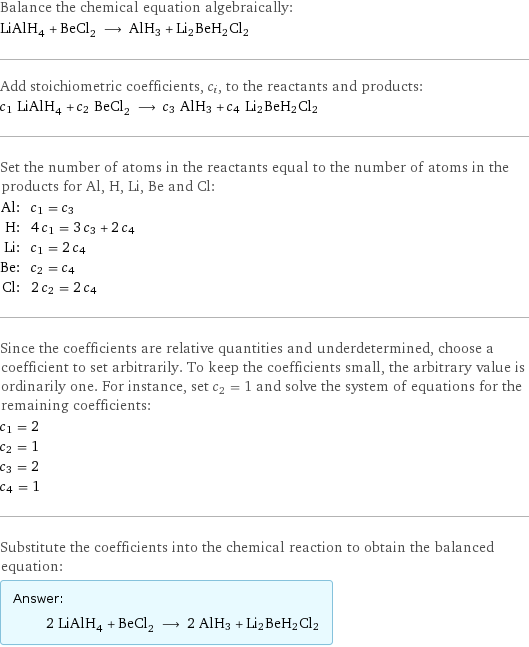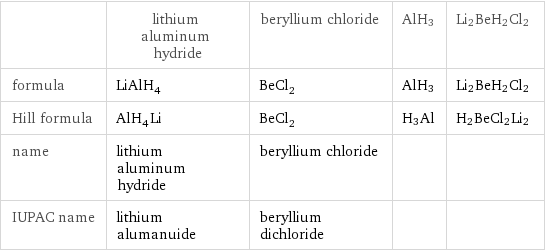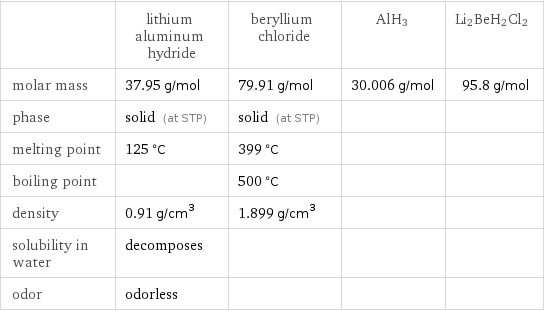Input interpretation

LiAlH_4 lithium aluminum hydride + BeCl_2 beryllium chloride ⟶ AlH3 + Li2BeH2Cl2
Balanced equation

Balance the chemical equation algebraically: LiAlH_4 + BeCl_2 ⟶ AlH3 + Li2BeH2Cl2 Add stoichiometric coefficients, c_i, to the reactants and products: c_1 LiAlH_4 + c_2 BeCl_2 ⟶ c_3 AlH3 + c_4 Li2BeH2Cl2 Set the number of atoms in the reactants equal to the number of atoms in the products for Al, H, Li, Be and Cl: Al: | c_1 = c_3 H: | 4 c_1 = 3 c_3 + 2 c_4 Li: | c_1 = 2 c_4 Be: | c_2 = c_4 Cl: | 2 c_2 = 2 c_4 Since the coefficients are relative quantities and underdetermined, choose a coefficient to set arbitrarily. To keep the coefficients small, the arbitrary value is ordinarily one. For instance, set c_2 = 1 and solve the system of equations for the remaining coefficients: c_1 = 2 c_2 = 1 c_3 = 2 c_4 = 1 Substitute the coefficients into the chemical reaction to obtain the balanced equation: Answer: | | 2 LiAlH_4 + BeCl_2 ⟶ 2 AlH3 + Li2BeH2Cl2
Structures

+ ⟶ AlH3 + Li2BeH2Cl2
Names

lithium aluminum hydride + beryllium chloride ⟶ AlH3 + Li2BeH2Cl2
Equilibrium constant
![Construct the equilibrium constant, K, expression for: LiAlH_4 + BeCl_2 ⟶ AlH3 + Li2BeH2Cl2 Plan: • Balance the chemical equation. • Determine the stoichiometric numbers. • Assemble the activity expression for each chemical species. • Use the activity expressions to build the equilibrium constant expression. Write the balanced chemical equation: 2 LiAlH_4 + BeCl_2 ⟶ 2 AlH3 + Li2BeH2Cl2 Assign stoichiometric numbers, ν_i, using the stoichiometric coefficients, c_i, from the balanced chemical equation in the following manner: ν_i = -c_i for reactants and ν_i = c_i for products: chemical species | c_i | ν_i LiAlH_4 | 2 | -2 BeCl_2 | 1 | -1 AlH3 | 2 | 2 Li2BeH2Cl2 | 1 | 1 Assemble the activity expressions accounting for the state of matter and ν_i: chemical species | c_i | ν_i | activity expression LiAlH_4 | 2 | -2 | ([LiAlH4])^(-2) BeCl_2 | 1 | -1 | ([BeCl2])^(-1) AlH3 | 2 | 2 | ([AlH3])^2 Li2BeH2Cl2 | 1 | 1 | [Li2BeH2Cl2] The equilibrium constant symbol in the concentration basis is: K_c Mulitply the activity expressions to arrive at the K_c expression: Answer: | | K_c = ([LiAlH4])^(-2) ([BeCl2])^(-1) ([AlH3])^2 [Li2BeH2Cl2] = (([AlH3])^2 [Li2BeH2Cl2])/(([LiAlH4])^2 [BeCl2])](../image_source/58811f67c56a32408e35f7a8f149860e.png)
Construct the equilibrium constant, K, expression for: LiAlH_4 + BeCl_2 ⟶ AlH3 + Li2BeH2Cl2 Plan: • Balance the chemical equation. • Determine the stoichiometric numbers. • Assemble the activity expression for each chemical species. • Use the activity expressions to build the equilibrium constant expression. Write the balanced chemical equation: 2 LiAlH_4 + BeCl_2 ⟶ 2 AlH3 + Li2BeH2Cl2 Assign stoichiometric numbers, ν_i, using the stoichiometric coefficients, c_i, from the balanced chemical equation in the following manner: ν_i = -c_i for reactants and ν_i = c_i for products: chemical species | c_i | ν_i LiAlH_4 | 2 | -2 BeCl_2 | 1 | -1 AlH3 | 2 | 2 Li2BeH2Cl2 | 1 | 1 Assemble the activity expressions accounting for the state of matter and ν_i: chemical species | c_i | ν_i | activity expression LiAlH_4 | 2 | -2 | ([LiAlH4])^(-2) BeCl_2 | 1 | -1 | ([BeCl2])^(-1) AlH3 | 2 | 2 | ([AlH3])^2 Li2BeH2Cl2 | 1 | 1 | [Li2BeH2Cl2] The equilibrium constant symbol in the concentration basis is: K_c Mulitply the activity expressions to arrive at the K_c expression: Answer: | | K_c = ([LiAlH4])^(-2) ([BeCl2])^(-1) ([AlH3])^2 [Li2BeH2Cl2] = (([AlH3])^2 [Li2BeH2Cl2])/(([LiAlH4])^2 [BeCl2])
Rate of reaction
![Construct the rate of reaction expression for: LiAlH_4 + BeCl_2 ⟶ AlH3 + Li2BeH2Cl2 Plan: • Balance the chemical equation. • Determine the stoichiometric numbers. • Assemble the rate term for each chemical species. • Write the rate of reaction expression. Write the balanced chemical equation: 2 LiAlH_4 + BeCl_2 ⟶ 2 AlH3 + Li2BeH2Cl2 Assign stoichiometric numbers, ν_i, using the stoichiometric coefficients, c_i, from the balanced chemical equation in the following manner: ν_i = -c_i for reactants and ν_i = c_i for products: chemical species | c_i | ν_i LiAlH_4 | 2 | -2 BeCl_2 | 1 | -1 AlH3 | 2 | 2 Li2BeH2Cl2 | 1 | 1 The rate term for each chemical species, B_i, is 1/ν_i(Δ[B_i])/(Δt) where [B_i] is the amount concentration and t is time: chemical species | c_i | ν_i | rate term LiAlH_4 | 2 | -2 | -1/2 (Δ[LiAlH4])/(Δt) BeCl_2 | 1 | -1 | -(Δ[BeCl2])/(Δt) AlH3 | 2 | 2 | 1/2 (Δ[AlH3])/(Δt) Li2BeH2Cl2 | 1 | 1 | (Δ[Li2BeH2Cl2])/(Δt) (for infinitesimal rate of change, replace Δ with d) Set the rate terms equal to each other to arrive at the rate expression: Answer: | | rate = -1/2 (Δ[LiAlH4])/(Δt) = -(Δ[BeCl2])/(Δt) = 1/2 (Δ[AlH3])/(Δt) = (Δ[Li2BeH2Cl2])/(Δt) (assuming constant volume and no accumulation of intermediates or side products)](../image_source/620cc8d0b5226a203807ad74928dc0f5.png)
Construct the rate of reaction expression for: LiAlH_4 + BeCl_2 ⟶ AlH3 + Li2BeH2Cl2 Plan: • Balance the chemical equation. • Determine the stoichiometric numbers. • Assemble the rate term for each chemical species. • Write the rate of reaction expression. Write the balanced chemical equation: 2 LiAlH_4 + BeCl_2 ⟶ 2 AlH3 + Li2BeH2Cl2 Assign stoichiometric numbers, ν_i, using the stoichiometric coefficients, c_i, from the balanced chemical equation in the following manner: ν_i = -c_i for reactants and ν_i = c_i for products: chemical species | c_i | ν_i LiAlH_4 | 2 | -2 BeCl_2 | 1 | -1 AlH3 | 2 | 2 Li2BeH2Cl2 | 1 | 1 The rate term for each chemical species, B_i, is 1/ν_i(Δ[B_i])/(Δt) where [B_i] is the amount concentration and t is time: chemical species | c_i | ν_i | rate term LiAlH_4 | 2 | -2 | -1/2 (Δ[LiAlH4])/(Δt) BeCl_2 | 1 | -1 | -(Δ[BeCl2])/(Δt) AlH3 | 2 | 2 | 1/2 (Δ[AlH3])/(Δt) Li2BeH2Cl2 | 1 | 1 | (Δ[Li2BeH2Cl2])/(Δt) (for infinitesimal rate of change, replace Δ with d) Set the rate terms equal to each other to arrive at the rate expression: Answer: | | rate = -1/2 (Δ[LiAlH4])/(Δt) = -(Δ[BeCl2])/(Δt) = 1/2 (Δ[AlH3])/(Δt) = (Δ[Li2BeH2Cl2])/(Δt) (assuming constant volume and no accumulation of intermediates or side products)
Chemical names and formulas

| lithium aluminum hydride | beryllium chloride | AlH3 | Li2BeH2Cl2 formula | LiAlH_4 | BeCl_2 | AlH3 | Li2BeH2Cl2 Hill formula | AlH_4Li | BeCl_2 | H3Al | H2BeCl2Li2 name | lithium aluminum hydride | beryllium chloride | | IUPAC name | lithium alumanuide | beryllium dichloride | |
Substance properties

| lithium aluminum hydride | beryllium chloride | AlH3 | Li2BeH2Cl2 molar mass | 37.95 g/mol | 79.91 g/mol | 30.006 g/mol | 95.8 g/mol phase | solid (at STP) | solid (at STP) | | melting point | 125 °C | 399 °C | | boiling point | | 500 °C | | density | 0.91 g/cm^3 | 1.899 g/cm^3 | | solubility in water | decomposes | | | odor | odorless | | |
Units
